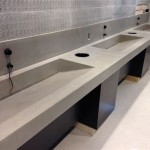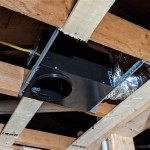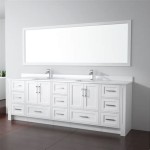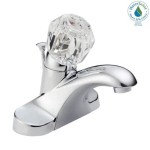Understanding Sink Faucet Bathroom Parts: A Comprehensive Guide
Bathroom sink faucets are essential fixtures, providing a necessary function and contributing to the overall aesthetic appeal of a bathroom. While the finished faucet presents a cohesive appearance, it comprises numerous individual parts, each crucial for its proper operation. Understanding these components allows for informed decision-making during purchase, maintenance, and repairs. This article will delve into the various parts of a sink faucet, examining their functions and common issues that may arise.
The composition of a sink faucet can vary based on its style, design, and manufacturer. However, certain fundamental parts are common across most faucet types. These include the faucet body, handles, spout, cartridge or valve, aerator, and supply lines. Each part plays a distinct role in controlling water flow, temperature, and direction.
Key Component: The Faucet Body and Spout
The faucet body serves as the central structural element, housing the internal components and providing a connection point to the sink. It is typically constructed from brass, stainless steel, or zinc alloys, chosen for their durability and resistance to corrosion. The body's design dictates the faucet's overall style and mounting configuration, such as single-hole, centerset, or widespread.
The spout is the outlet through which water flows. Its design can range from simple curved shapes to elaborate gooseneck styles. The spout's material usually matches the faucet body, and it often features a chrome, nickel, or other decorative finish. The spout's height and reach are important considerations during faucet selection, influencing the ease of use and suitability for various sink sizes and depths.
Within the faucet body are internal waterways that channel water from the supply lines to the spout. These pathways are carefully engineered to ensure smooth and efficient water flow. The body also houses the valve or cartridge mechanism, responsible for controlling the on/off function and temperature mixing.
Common issues relating to the faucet body include leaks around the base, corrosion of the material especially in areas with hard water, and damage to the threads that connect to the supply lines. Minor leaks can sometimes be addressed by tightening connections, while more severe issues may necessitate faucet replacement.
Core Function: Handles and Control Mechanisms
Faucet handles are the user interface for controlling water flow and temperature. They come in various designs, including lever handles, knob handles, and cross handles. The choice of handle style is largely a matter of personal preference and aesthetic compatibility with the bathroom décor.
The handle mechanism is directly linked to the valve or cartridge, which regulates the water flow. Single-handle faucets typically employ a cartridge system, where a single lever controls both water flow and temperature by rotating the cartridge within the faucet body. Two-handle faucets, on the other hand, often use separate valves – one for hot water and one for cold water – allowing for independent control of each. Ceramic disc valves are a popular choice due to their durability and smooth operation. Ball valves and compression stem valves are older technologies but can still be found in some faucets.
Cartridge repair is a common maintenance task. Over time, mineral deposits can accumulate within the cartridge, leading to stiffness, leaks, or reduced water flow. Cleaning or replacing the cartridge can often resolve these issues. Similarly, valves in two-handle faucets can wear down over time, requiring replacement to prevent leaks.
The connection between the handle and the cartridge or valve must be secure and properly aligned. Loosening or misalignment can result in difficulty controlling the water flow or temperature. Regular inspection and tightening of screws or set screws can help prevent these problems.
Another type of control mechanism found in modern faucets is touchless technology. These faucets utilize sensors to detect the presence of hands, automatically activating the water flow. Touchless faucets often employ solenoid valves to control the water flow electronically. They enhance hygiene and conserve water, but the electronic components require a power source (either batteries or a direct electrical connection) and may require specialized repair.
Essential Detail: Aerators and Supply Lines
The aerator is a small component located at the tip of the spout. It mixes air into the water stream, creating a soft, splash-free flow. Aerators also help conserve water by reducing the overall water volume without compromising water pressure. Many aerators can be easily unscrewed for cleaning or replacement.
The aerator's function is to break up the water stream into smaller droplets and introduce air bubbles. This process reduces the force of the water hitting the sink basin, minimizing splashing and noise. The aerator also helps distribute the water evenly, providing a more comfortable and efficient washing experience. Different aerator designs are available, with varying flow rates and spray patterns.
Regular cleaning of the aerator is essential to maintain its performance. Mineral deposits and debris can accumulate within the aerator screen, restricting water flow and causing inconsistent spray patterns. Soaking the aerator in vinegar or a descaling solution can effectively remove these deposits. In some cases, the aerator may need to be replaced if it is damaged or severely clogged.
Supply lines connect the faucet to the water supply pipes in the wall or floor. These lines are typically made of flexible braided stainless steel or copper tubing. They provide a reliable and leak-proof connection, allowing water to flow from the main water supply to the faucet. The correct length and diameter of supply lines are crucial for proper faucet installation.
Flexible supply lines offer greater ease of installation compared to rigid copper pipes, particularly in tight spaces. However, they should be inspected periodically for signs of wear or damage, such as kinks, cracks, or corrosion. Damaged supply lines can lead to leaks, which can cause water damage to the surrounding area. Replacing supply lines is a relatively simple task that can prevent costly repairs.
Shut-off valves are typically located on the water supply pipes beneath the sink. These valves allow the water supply to be shut off to the faucet without affecting the entire household's water system. This is essential for performing maintenance or repairs on the faucet. Ensuring that these shut-off valves are functioning properly is a crucial aspect of bathroom plumbing maintenance.
The connection between the supply lines and the faucet body requires a tight seal to prevent leaks. Teflon tape or pipe dope can be used on the threads to create a watertight connection. Overtightening connections can damage the threads, so it is important to use the correct amount of sealant and avoid excessive force.
Beyond the core components mentioned above, other parts can contribute to the functionality and aesthetics of sink faucets. These include decorative escutcheons, which conceal the mounting holes in the sink or countertop; pop-up drain assemblies, which allow for easy opening and closing of the sink drain; and soap dispensers, which are often integrated into the faucet body.
An escutcheon is a decorative plate that covers the area where the faucet connects to the sink or countertop. It is primarily aesthetic, concealing the mounting hardware and providing a cleaner, more finished look. Escutcheons come in various styles and finishes to match the faucet and bathroom décor.
A pop-up drain assembly consists of a drain flange, a stopper, and a linkage mechanism. The stopper is connected to a lever or knob, allowing the user to easily open and close the drain. Pop-up drains are convenient for filling the sink with water or quickly draining it. Regular cleaning of the drain assembly is necessary to prevent clogs and maintain proper drainage.
Integrated soap dispensers offer a convenient and space-saving solution for dispensing liquid soap or lotion. They are typically mounted adjacent to the faucet spout and feature a pump mechanism that dispenses soap directly into the user's hand. Soap dispensers require periodic refilling and cleaning to prevent clogs and ensure proper operation.
Understanding the various parts of a sink faucet is essential for proper maintenance and repair. While some repairs may require specialized tools or expertise, many common issues can be resolved with basic knowledge and simple tools. Regular inspection and preventive maintenance can help prolong the life of a sink faucet and prevent costly repairs.
The selection of a sink faucet depends on various factors, including personal preference, budget, and the existing plumbing configuration. Considering the functionality, durability, and aesthetic appeal of different faucet designs can help ensure a satisfying and long-lasting purchase. Consulting with a plumbing professional can provide valuable guidance and ensure proper installation.

New Bathroom Faucet Parts Great 46 For Home Office Inspiration With American Standard Kitchen

Bathroom Sink Drain Parts Diagram Http Www Designbabylon Interiors Com Di Faucet Faucets

Valley Single Handle Bathroom Faucet Repair Parts

Delta Faucet Repair Parts In 2024 Bathroom

Valley Single Handle Bathroom Faucet Repair Parts

Parts Of A Sink The Home Depot

Rless Brand Faucet Repair Parts

Faucet Diagrams Google Search Parts Kitchen

Waterfall Bathroom Faucet Bath Brushed Nickel Farmhouse Sink Vanity Single Handle Satin Faucets Lavatory One Hole Lever Basin Mixer Tap Commercial Deck Mount Supply Hose Lead Free Com

Parts For Handle Bathroom Faucet Kitchen Sink Taps Repair Faucets
Related Posts







